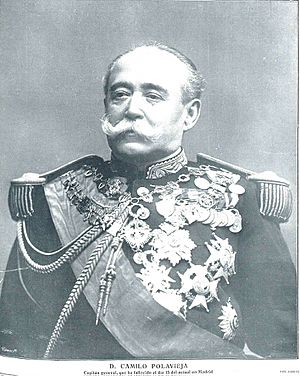Camilo García de Polavieja facts for kids
Quick facts for kids
The Most Excellent
The Marquess of Polavieja
|
|
|---|---|

Photograph by Kaulak
|
|
| 113th Governor-General of the Philippines | |
| In office December 13, 1896 – April 15, 1897 |
|
| Monarch | Alfonso XIII of Spain |
| Preceded by | Ramón Blanco y Erenas |
| Succeeded by | José de Lachambre |
| Governor of Cuba | |
| In office August 24, 1890 – 1892 |
|
| Preceded by | José Chinchilla |
| Succeeded by | Alejandro Rodríguez Arias |
| Governor of Puerto Rico | |
| In office 1888–1889 |
|
| Personal details | |
| Born | 13 July 1838 Madrid, Spain |
| Died | 15 January 1914 (aged 75) Madrid, Spain |
| Military service | |
| Allegiance | |
| Rank | |
| Battles/wars | Third Carlist War, Ten Years' War, Philippine Revolution |
Camilo García de Polavieja y del Castillo-Negrete, 1st Marquess of Polavieja (13 July 1838 – 15 January 1914) was a Spanish general. He was born in Madrid, Spain, on July 13, 1838. His family were merchants. Polavieja was known as a skilled military leader.
Contents
Early Military Career
Camilo Polavieja joined the Navarro Regiment in 1855. He showed great bravery during battles in Africa. For his courage, he received the Cross of Isabelle Maria Lucia.
Wars and Promotions
Polavieja later fought in the Ten Years' War in Cuba. Spain sent many soldiers to this war. He also took part in the Third Carlist War in Spain. By 1876, he became a brigadier general. He was then sent back to Cuba. There, he was promoted to Field Marshal. He also received the Cross of Military Merit.
Return to Spain
In 1882, Polavieja returned to Spain. He became a member of the Supreme Council of War and Navy. This was a very important group. He also served as Captain general of Andalusia. This role made him the top military leader in that region. He was also the Supreme Chief of Infantry Inspection.
Serving in the Colonies
Polavieja held important leadership roles in Spain's colonies. He served as governor in Puerto Rico and Cuba.
Governor of Puerto Rico
In 1888, Polavieja became the Governor general of Puerto Rico. He held this position for about a year. He resigned from this role in 1889.
Governor of Cuba
A year later, in 1890, he was sent to Cuba. He took over as Captain general from José Chinchilla. Polavieja was known as a very capable administrator. He resigned in 1892. He did this to protest against corruption by a politician named Romero de Robledo. This politician was known for dishonest practices.
Governor General of the Philippines
The revolution in Cuba inspired people in the Philippines to revolt. The Philippines was Spain's last major colony. The Spanish government tried to stop the Philippine Revolution. Ramón Blanco y Erenas was the governor at the time.
Taking Command in the Philippines
As the rebellion grew, Polavieja took over as Governor general. He was Blanco's second-in-command. A Filipino historian, Gregorio Zaide, noted that powerful Spanish friars helped Polavieja get this position. The Archbishop of Manila was one of them.
José Rizal's Execution
Polavieja oversaw the trial and execution of José Rizal. Rizal was a Filipino national hero. He was executed on December 30, 1896. Twenty-four other people were also executed with Rizal.
Military Actions in the Philippines
In August 1896, Spain had few soldiers in the Philippines. There were about 500 soldiers in Manila. Another 700 were in the rest of the islands. By January 1897, many more soldiers arrived from Spain. Governor Polavieja had over 12,000 men. He used them to fight the rebels in Luzon.
On February 13, 1897, Polavieja started his Cavite campaign. He advanced against the revolutionaries with 16,000 men. Many of his soldiers were from Pampanga. They were led by General José de Lachambre. Polavieja managed to scatter most of the main rebel groups in Cavite. About 4,000 rebels died in jails in Manila. Polavieja resigned because of his poor health.
Later Life and Death
After returning to Spain, Polavieja faced criticism. People blamed him for Spain losing the Philippines to the United States. When he visited Girona, people handed out papers with Rizal's last poems. They also had Rizal's picture. These papers said Polavieja was responsible for the loss of the Philippines. Ramon Blanco later gave his sash and sword to Rizal's family as an apology.
Polavieja continued to influence the Spanish government. He tried to prepare for a neutral political party. However, his ideas were not allowed to be published. He died in 1914 from hepatitis.
Media Portrayal
- Portrayed by Tony Mabesa in the 1998 film, José Rizal.
See also
 In Spanish: Camilo García de Polavieja para niños
In Spanish: Camilo García de Polavieja para niños

